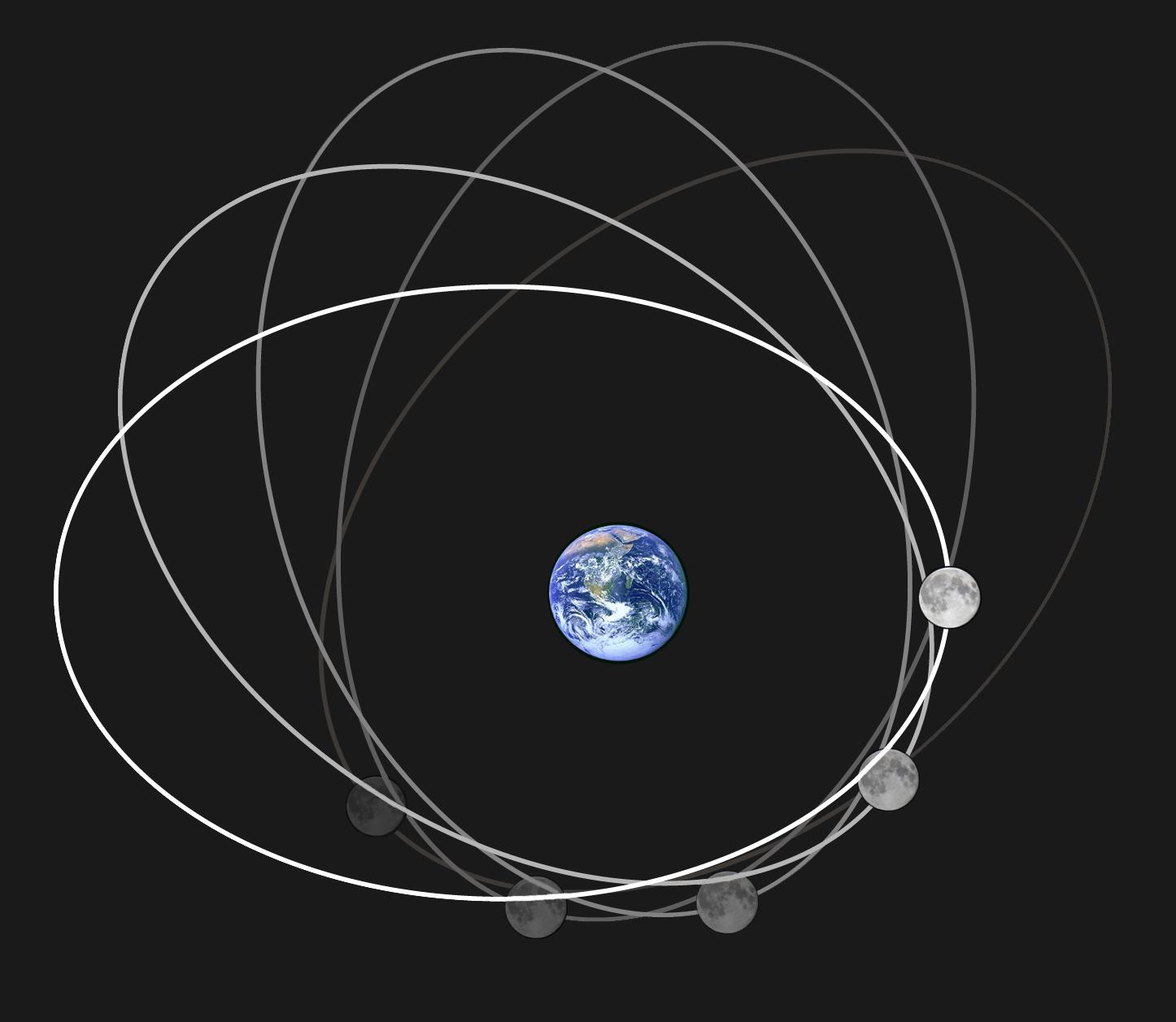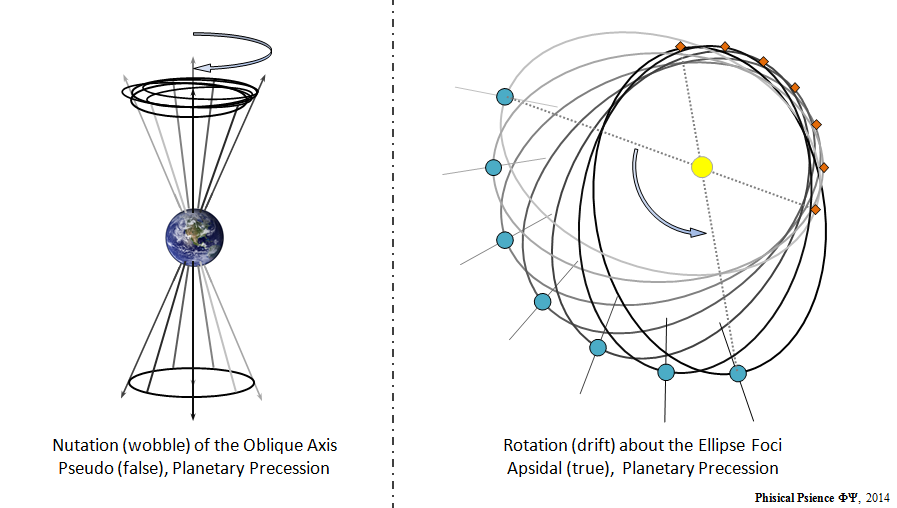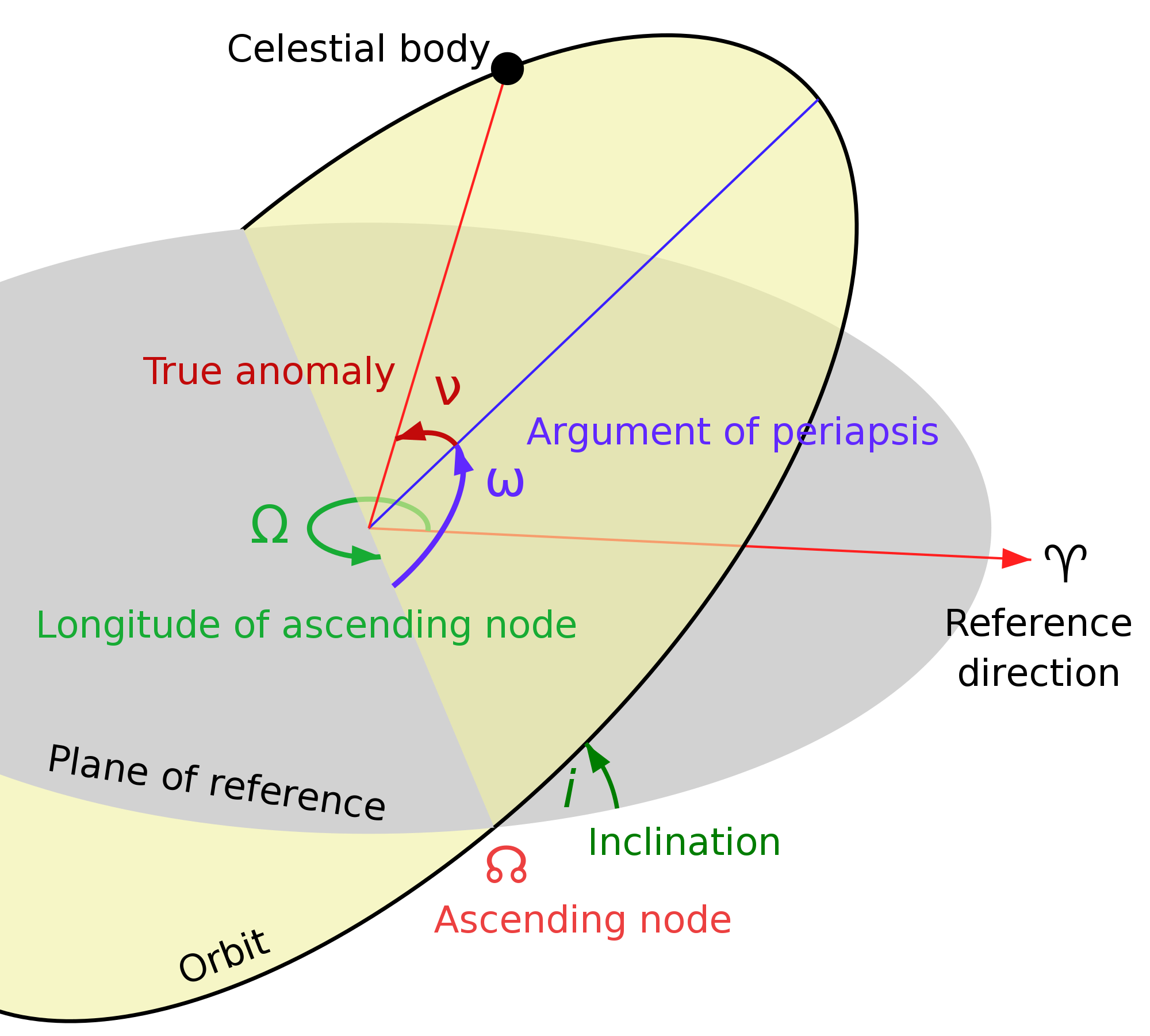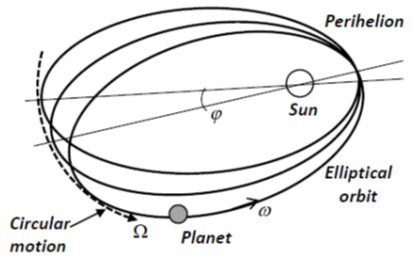Apsidal precession
The Apsidendrehung an elliptical orbit is a progressive rotation of the whole web in the orbital plane. Here, the line of apsides rotates continuously while the form and level of the path in space remain the same. Depending on the central body also the following notations are used:
- Perihelion, or precession of the perihelion, when the train runs around the sun and
- Perigäumsdrehung when the web runs around the earth.
If this movement is sometimes referred to as " precession " of the pericentre, it must not be confused with the similar sounding precession of the equinoxes, which is indeed also is a track fault, but in which the position of a plane is affected in space.
- 3.1 planetary orbits
- 3.2 moon
- 3.3 Artificial Satellites
- 3.4 Relativistic perihelion
- 3.5 Exotic Systems
Causes
A Apsidendrehung occurs when a celestial body subject to its elliptical orbit around a central body certain external disturbances. Had the celestial body of an attractive force exposed, which decreases quadratically strictly inversely with distance from the central body, he would move exactly on a Kepler ellipse whose shape, position and orientation remained unchanged in the room. However, deviations from the strict reverse- square force law lead to different types of perturbations, could alter the shape, position and orientation of the orbit. One of these perturbations is the Apsidendrehung.
- A possible reason for deviations from the ideal power law is the presence of other bodies which exert additional gravitational forces on the observed celestial body. In the case of planetary orbits, the influence of the other planets is the main cause for the Periheldrehungen.
- Another cause may be deviations of the central body from the spherical shape. While a perfect sphere symmetrically constructed extensive body would produce the same strict inverse square gravitational field as a point-like bodies of the same mass, cause irregular mass distributions or the equatorial bulge oblate central body turn to deviations from the inverse square law of force and thus perturbations. The equatorial bulge of the Earth caused (among other perturbations ) Perigäumsdrehungen in artificial satellites. The flattening of the sun causes Periheldrehungen of the planetary orbits, which, however, are much smaller because of the smallness of the flattening and the large distance of the planet as the rotations of each other caused by the planet.
- Finally, the physically real force law can in principle differ from the idealized inverse- square behavior. According to the general theory of relativity, this is for the gravitational fields, which are exposed to the planet, indeed the case, so that a further contribution to the Periheldrehungen the planet (even if only to a very limited extent ).
For all these reasons results - in a with respect to the fixed star background stationary coordinate system - a rosette-like movement of the body: The anomalistic period is not exactly the sidereal. Mechanically the sky by a long-period term of the track element argument of pericentre is described.
The web is not described in relation to the fixed star background stationary reference system, but in a rotating reference system, leads to the above-described physically caused rotations add an additional apparent movement, which merely reflects the rotation of the reference system. In the case of the planetary orbits of the solar system be the Periheldrehungen - counted by a spring fixed point selected from - only fractions of a degree per century. Are the railways on the other hand described with respect to the moving equinox of the date, so are their speeds in this rotating frame of reference to the precession of the vernal equinox, namely 1.396 ° per century, higher and range from one to two degrees per century.
Episodes from the history of research
Movement of apogees
Already the ancient astronomers was known by observation that the sun, moon and planets do not go through their orbits at constant speeds. Greek astronomers considered this in their planetary theories by could not be coincident with the center of the earth adopted in the center of the universe, the center of each to be circular presupposed planetary orbit, but, not to be confused in a suitable direction by a certain amount ( the eccentricity called with the eccentricity of an ellipse ) offset. In the past the observer closer run half the planet now running smoothly moved seemingly faster than on the opposite half. As can be seen, the real, the second Kepler's law, the following velocity profile of a planet in a very good approximation can be computationally reconstructed by means of a suitable shifted circular path ( an eccentric so-called ). Hipparchus, for example, rule out the unequal lengths of the seasons in the velocity variation of the (then treated as a planet ) sun in the individual path quadrant and described her circulation by a circle, which at 1/24 of its radius in the direction of 65.5 ° was moved. In this direction, so was also the apogee of the ecliptic, the ecliptic longitude at that time actually 66.23 °, respectively. ( At that time, the apogee was used as a reference, while today it is preferable to the perigee. )
Ptolemy repeated the orbit determination 300 years later. However, since his observations were the same lengths for the seasons, he also received the same path of the sun and therefore held the position of its apogee immutable with respect to the Äquinoktialpunkte:
However, unlike behaved the apogees of the other planets. From the results of numerous observations and analyzes, he concluded that their apogees not rest with respect to the Äquinoktialpunkte, but with respect to the fixed stars. This is remarkable, as in his opinion ( and in contrast to today's point of view ) the Äquinoktialpunkte were regarded as being at rest and moves the fixed stars as a result of the precession. Accordingly, he held the apogees for mobile, and their speed had to be determined. The observations showed him that they are all about the same speed prograde motion and that their speed was consistent within the accuracy of observation with the precession of the fixed stars; he found that
In the 9th century saw Thabit ibn Qurrah that even the Sonnenapogäum performed a rechtläufige movement relative to the Äquinoktialpunkte. This movement was thought at first however as the Planetenapogäen for purely präzessionsbedingt. Al- Battani, for example, put the Sonnenapogäum for March 1 880 to 82 ° 15 ' ecliptic longitude and gave instructions for computing the Apogäumslänge to add at different times for each elapsed 66 years 1 ° Präzessionsverschiebung or deducted:
The same was true for him, as it did for Ptolemy, for apogees the planet:
Only Ibn al - Shatir introduced in the 14th century, established by observation that the Sonnenapogäum not migrated exactly with the rate of precession (ie, with 1 ° per 60 Persian years compared to 1 ° per 70 Persian years ), so moved independently with respect to the fixed stars.
In contrast to the planet orbits the Perigäumsdrehung the moon was already known to the Babylonian astronomers and explicitly taken into account in their calculation schemes. Hipparchus and Ptolemy took over from Babylonian astronomy basic numbers and worked on detailed moon theories based on the Epizykelmodells from.
Perihelion of Mercury
The elliptical shape of planetary orbits was first described in 1609 empirically by Kepler's laws. The physical justification followed until the mid- 17th century with the celestial mechanics of Isaac Newton. With its universal power law of gravity descriptive, it had also become possible to study the perturbations in more detail, which exert the planets with each other. In particular, the observed Apsidendrehungen of the planets and the moon could be almost completely explained by Newton's theory.
In the mid-19th century, however, Urbain Le Verrier used observations of Mercury passes for a particularly accurate measurement of Mercury's orbit and it was clear from improved data that Mercury's perihelion advance something was stronger than expected. After the celestial mechanics calculations, they should " be per century, with about 280 about 530 arc seconds ()" was attributable to the influence of Venus, about 150 " to interference from Jupiter and about 100 " to the rest of the planet. The observed perihelion ( modern value: 571.91 " / century) but was significantly greater; the modern value for the discrepancy is 43.11 ".
Le Verrier, who had already successfully made possible by investigation of unexplained share in the perturbations of Uranus, the discovery of Neptune are suspected as the cause of the discrepancy in Mercury interference from a previously unknown planet in an orbit within the orbit of Mercury. This was called the volcano, but was despite extensive search - including during some eclipses - not detected. Likewise, no responsible for the disturbances close to the Sun asteroid belt could be detected. Other suspects responsible for the zodiacal dust belt or saw at least part of the cause in a rotation because of their flattened shape of the sun ( see also below), but were ultimately also unsuccessful.
More explanations attracted the validity of Newton 's second law in doubt. It succeeded on the basis of electrodynamic force law, for example, Levy (1890) and in particular Paul Gerber (1898), fully drain the excess, on condition that the velocity of propagation of gravity is equal to the speed of light. Gerber's formula for the Perihelabweichung was formally established later already identical to that of Einstein. However, the underlying force laws were wrong and the theories of this kind had to be discarded.
Only the General Theory of Relativity by Albert Einstein, which describes gravity as a curvature of space- time, their structure and the world body in turn have an influence could explain the excess convincing. This success is regarded as one of the mainstays of general relativity and as their first major confirmation. The relativistically calculated proportion of 42.98 " agrees quite well with the observed excess of 43.11 " match. The cause of the relativistic effect is the slight deviation of the relativistic gravitational field treated from a strictly inverse square behavior.
The agreement between observation and relativistic bill would be less good if a significant portion of the observed excess would be due to a rotationally -induced flattening of the sun and the remaining to be explained share would therefore be significantly lower than calculated according to ART. Attempts to measure the extremely low oblateness of the sun, delivered over a long period contradictory results, so that always remained a little iffy on how well the compliance of the relativistic prediction with the observation actually was. However Helioseismologische studies the quadrupole moment of the sun reliably (2.18 ± 0.06) · 10-7 have now determined; this quadrupole moment yields only a contribution of a few hundredths of arcseconds to perihelion and is therefore negligible. Another way to determine utilizes the fact that the relativistic and -related share of the total perihelion distance increases fall away from the sun at different rates and can thus be separated by comparing the total spins of different planets from each other. Such a study provided by = ( 1.9 ± 0.3 ) · 10-7 practically the same result as helioseismology.
The table below lists some observation results of the last decades:
Examples
Planetary orbits
The orbits of all the planets of the solar system are - mainly because of their mutual interference - continuous Periheldrehungen in the direction of the orbital motion. The following table lists the amounts of these rotations on both with respect to the vernal equinox ( " tropical" ) as well as with respect to the fixed star background ( " sidereal "). The numerical values are long term easily changeable and are also subject to minor shorter -term fluctuations. The specified values describe the average motion ( ie under settlement of short-term fluctuations ) for the beginning of 2000 (that is, the epoch J2000.0 ).
The numerical values of the two columns differ by 1.396 ° per century, the rate of precession in ecliptic longitude. Thus the angle between the perihelion of the Earth and the spring equinox changes, for example, 1,720 ° / century, so that both take after about 21,000 years back the same to each other, which could have, among other effects on the climate (see Ice Age, Milankovitch cycles ). This cycle, however, is mainly determined by the rapid motion of the vernal equinox. The angle between the perihelion and an ( infinitely far away imaginary) fixed star changes, however, only at a rate of 0.323 ° / century, so that the perihelion need 110,000 years to orbit relative to the inertial space once the Earth's orbit. This is the rate of perihelion, as it is caused due to external interference.
The extent of perihelion depends, among other things, of the eccentricity of the respective web. Venus with its almost circular orbit therefore has a remarkably low sidereal perihelion.
Moon
The apsides of the moon rotates in 8.85 years around the entire lunar orbit. The main cause of this is the sun, which acts as a third, disturbing impact on the orbit of the moon around the earth.
This cycle of the apses (English lunar apse cycle, perigee cycle) is calculated:
The cycle can be found in the variation of the lunations, and is well studied as a period of tidal and meteorological phenomena.
Artificial Satellites
Perigäumsdrehungen of satellites are presented as basic satellite orbit element. Its cause is the oblateness of the earth and satellites in low orbit, where appropriate, in the atmosphere of friction. The Perigäumsdrehung the GPS satellites orbiting the earth at an altitude of about 20,200 kilometers, is about 0.01 ° per day.
If one describes the deviation from the spherical shape of the Erdgravitationspotentials simplified by restriction to be quadrupole moment, so is the motion of the perigee
For slopes less than 63.4 °, the perigee is moving in the direction of the satellite. For inclinations about it moves decline. If the satellite is an orbital inclination of 63.4 °, so it is subject to ( approximately) no Perigäumsdrehung because. If its orbital period beyond about 12 hours (or more precisely half a sidereal day) and choose the path very eccentric, so the apogee lies during each orbit a long time on the same region of the Earth's surface and the satellite can be used, for example, favorable for telecommunications purposes. It is located in a so-called Molniya orbit.
Relativistic perihelion
The relativistic contribution to the perihelion advance was next to Mercury also in Venus, Earth, Mars and the asteroid Icarus be detected (see Table, Booth 1986). In the Earth, for example, the total observed rotation in 1161 " per century is; which is around 5 " more than is expected from the Newtonian theory of gravitation. This excess is well compatible with the relativistic prediction of 3.8 ".
For the relativistic perihelion advance of a planet applies:
The second form of the equation is obtained when the heliocentric gravitational constant is expressed by the Gaussian gravitational constant.
With the path data = 0.387099 AE, = 0.205630 and = 0.24085 years for Mercury is obtained as indicated in the table perihelion of 42.98 arc seconds per 100 years.
Exotic systems
In extreme form the Apsidendrehung particularly between massive heavenly bodies such as stars and neutron stars occurs. In the binary pulsar PSR 1913 16 ( a binary star system in which one of the two components is a pulsar ), the relativistic perihelion 4.2 ° per year, in the pulsar PSR J1906 0746 binary system it is 7.57 ° per year, PSR J0737 - 3039 and in ( in which both components are pulsars ) even 16.90 ° per year.
The light curve of the quasar OJ 287 suggests that in its center are two mutually orbiting black holes, whose mutual orbit per a 12-year circulation rotates by 39 °.
Long time it seemed the Apsidendrehung of the binary system DI Herculis to be in contradiction to the laws of physics, but the low rate of Apsidendrehung is caused by the position of the rotation axis in the orbital plane.










